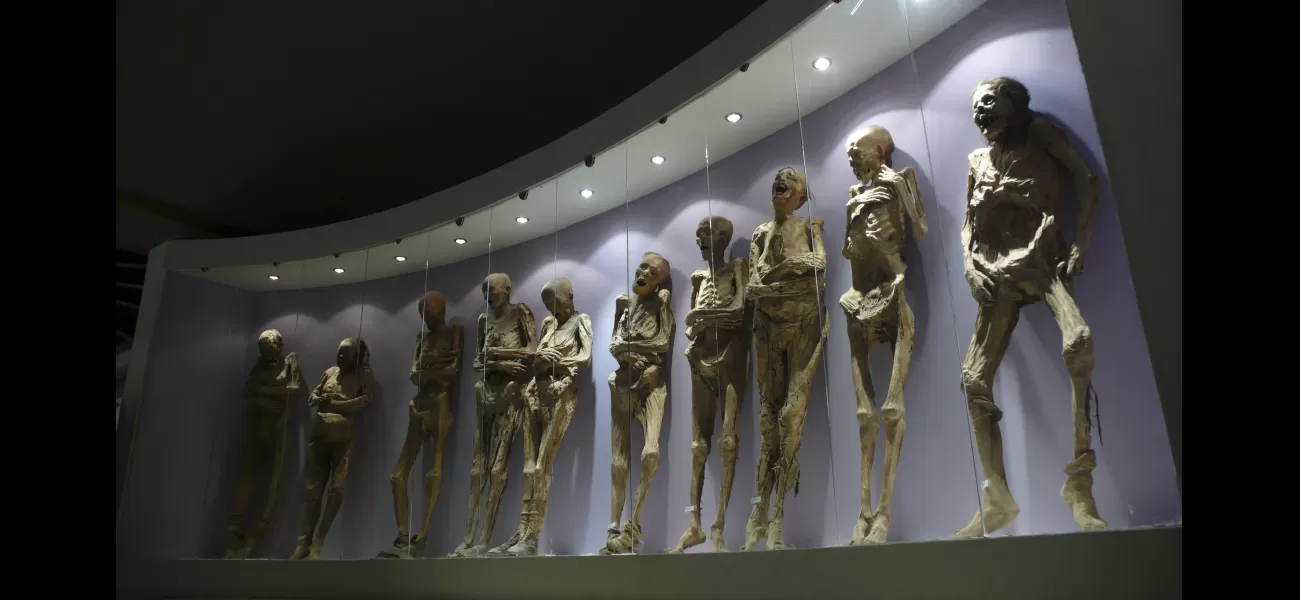Museum staff cause damage to famous mummy's arm due to mishandling.
Mexican agency accuses Guanajuato of mistreating famous mummified body from 19th century.
May 28th 2024.

The Federal Archaeology Agency of Mexico has brought forth allegations against the city of Guanajuato, governed by conservatives, for mishandling one of the nation's renowned mummified bodies from the 19th century. According to the National Institute of Anthropology and History (INAH), during recent renovations at the museum where the mummies are displayed, one of the mummies' arms was detached.
One might assume that the complaint revolves solely around the respectful treatment of corpses buried in the early 1800s, exhumed starting in the 1860s because their families couldn't afford to pay for burial fees. However, the truth is that these mummies have been on display in glass cases at the museum in Guanajuato, the capital of the state of the same name, and have even been showcased at tourism fairs for many years. In fact, some were even exhibited in the United States back in 2009.
The root cause of this dispute seems to be a power struggle between the INAH, who claims jurisdiction over the mummies as they are considered "national heritage," and Guanajuato, who sees them as a popular tourist attraction. Adding fuel to the fire is the fact that the state and city are governed by the conservative National Action Party, which is viewed as an arch-enemy by the Morena party, currently in power at the federal level.
In response to these recent events, the institute has announced that they will be demanding an explanation of the permits and procedures followed during the museum's renovations. In a statement, they expressed their disappointment, stating that the handling of the mummies during the move was not done correctly, resulting in damages, not just to the mummy in question, but potentially others as well. It appears that this situation could have been avoided if proper protocols were followed and the personnel in charge were adequately trained.
The city government of Guanajuato has yet to respond to these accusations. These preserved corpses were unintentionally mummified due to being buried in crypts in a dry, mineral-rich soil environment in the mining state of Guanajuato. Many of them still have their hair, leathery skin, and even their original clothing.
The INAH seems to be upset that the approximately 100 mummies are under the control of personnel in Guanajuato, rather than their own staff. This is partly because most of these mummies were unearthed before the institute was established in 1939, and thus remain under local jurisdiction. This has been a point of contention for federal officials in the past.
In 2023, the institute raised concerns about the health risks posed by a travelling display of the mummies, as one of them appeared to have fungal growths. This is not the first time that the extremity of a deceased person has caused a national political issue. In 1989, the Mexican government faced backlash after removing the arm of revolutionary General Álvaro Obregón, which had been on display in a jar of formaldehyde at a marble monument for fifty years. Visitors had deemed it "unsightly," and it was subsequently incinerated and buried. Similarly, in 1838, Antonio López de Santa Anna, who served as president of Mexico eleven times, had his leg buried with honors after losing it in battle. However, in 1844, an angry mob paraded the leg through the streets of Mexico City, accusing Santa Anna of treason and destroying the leg in the process.
One might assume that the complaint revolves solely around the respectful treatment of corpses buried in the early 1800s, exhumed starting in the 1860s because their families couldn't afford to pay for burial fees. However, the truth is that these mummies have been on display in glass cases at the museum in Guanajuato, the capital of the state of the same name, and have even been showcased at tourism fairs for many years. In fact, some were even exhibited in the United States back in 2009.
The root cause of this dispute seems to be a power struggle between the INAH, who claims jurisdiction over the mummies as they are considered "national heritage," and Guanajuato, who sees them as a popular tourist attraction. Adding fuel to the fire is the fact that the state and city are governed by the conservative National Action Party, which is viewed as an arch-enemy by the Morena party, currently in power at the federal level.
In response to these recent events, the institute has announced that they will be demanding an explanation of the permits and procedures followed during the museum's renovations. In a statement, they expressed their disappointment, stating that the handling of the mummies during the move was not done correctly, resulting in damages, not just to the mummy in question, but potentially others as well. It appears that this situation could have been avoided if proper protocols were followed and the personnel in charge were adequately trained.
The city government of Guanajuato has yet to respond to these accusations. These preserved corpses were unintentionally mummified due to being buried in crypts in a dry, mineral-rich soil environment in the mining state of Guanajuato. Many of them still have their hair, leathery skin, and even their original clothing.
The INAH seems to be upset that the approximately 100 mummies are under the control of personnel in Guanajuato, rather than their own staff. This is partly because most of these mummies were unearthed before the institute was established in 1939, and thus remain under local jurisdiction. This has been a point of contention for federal officials in the past.
In 2023, the institute raised concerns about the health risks posed by a travelling display of the mummies, as one of them appeared to have fungal growths. This is not the first time that the extremity of a deceased person has caused a national political issue. In 1989, the Mexican government faced backlash after removing the arm of revolutionary General Álvaro Obregón, which had been on display in a jar of formaldehyde at a marble monument for fifty years. Visitors had deemed it "unsightly," and it was subsequently incinerated and buried. Similarly, in 1838, Antonio López de Santa Anna, who served as president of Mexico eleven times, had his leg buried with honors after losing it in battle. However, in 1844, an angry mob paraded the leg through the streets of Mexico City, accusing Santa Anna of treason and destroying the leg in the process.
[This article has been trending online recently and has been generated with AI. Your feed is customized.]
[Generative AI is experimental.]
0
0
Submit Comment





